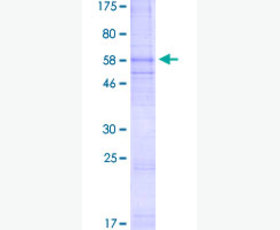Recombinant Human Lactotransferrin/LTF
| Product name: | Recombinant Human Lactotransferrin/LTF |
| Source: | Human Cells |
| Purity: | Greater than 95% as determined by reducing SDS-PAGE. |
| Buffer Formulation: | Lyophilized from a 0.2 μm filtered solution of 20mM PB,150mM NaCl,pH7.4. |
| Applications: | Applications:SDS-PAGE; WB; ELISA; IP. |
| Storage: | Avoid repeated freeze/thaw cycles. Store at 2-8 oC for one month. Aliquot and store at -80 oC for 12 months. |
| UOM: | 100ug/50ug/200ug/1mg/1g |
| Source | Human Cells |
| Description | Recombinant Human Lactotransferrin/LTF is produced by our Mammalian expression system and the target gene encoding Gly20-Lys710 is expressed with a 6His tag at the C-terminus. |
| Names | Lactotransferrin; Lactoferrin; Talalactoferrin; Kaliocin-1; Lactoferroxin-A; Lactoferroxin-B; Lactoferroxin-C; LTF; LF |
| Accession # | P02788 |
| Formulation | Lyophilized from a 0.2 μm filtered solution of 20mM PB,150mM NaCl,pH7.4. |
| Shipping |
The product is shipped at ambient temperature. |
| Reconstitution |
Always centrifuge tubes before opening. Do not mix by vortex or pipetting. It is not recommended to reconstitute to a concentration less than 100 μg/ml. Dissolve the lyophilized protein in ddH2O. Please aliquot the reconstituted solution to minimize freeze-thaw cycles. |
| Storage |
Lyophilized protein should be stored at < -20°C, though stable at room temperature for 3 weeks. Reconstituted protein solution can be stored at 4-7°C for 2-7 days. Aliquots of reconstituted samples are stable at < -20°C for 3 months. |
| Purity |
Greater than 95% as determined by reducing SDS-PAGE. |
| Endotoxin | Less than 0.1 ng/µg (1 IEU/µg) as determined by LAL test. |
| Amino Acid Sequence |
GSRRRSVQWCAVSQPEATKCFQWQRNMRKVRGPPVSCIKRDSPIQCIQAIAENRADAVTLDGGFI YEAGLAPYKLRPVAAEVYGTERQPRTHYYAVAVVKKGGSFQLNELQGLKSCHTGLRRTAGWNVPI GTLRPFLNWTGPPEPIEAAVARFFSASCVPGADKGQFPNLCRLCAGTGENKCAFSSQEPYFSYSG AFKCLRDGAGDVAFIRESTVFEDLSDEAERDEYELLCPDNTRKPVDKFKDCHLARVPSHAVVARS VNGKEDAIWNLLRQAQEKFGKDKSPKFQLFGSPSGQKDLLFKDSAIGFSRVPPRIDSGLYLGSGY FTAIQNLRKSEEEVAARRARVVWCAVGEQELRKCNQWSGLSEGSVTCSSASTTEDCIALVLKGEA DAMSLDGGYVYTAGKCGLVPVLAENYKSQQSSDPDPNCVDRPVEGYLTVAVVRRSDTSLTWNSVK GKKSCHTAVDRTAGWNIPMGLLFNQTGSCKFDEYFSQSCAPGSDPRSNLCALCIGDEQGENKCEP NSNERYYGYTGAFRCLAENAGDVAFVKDVTVLQNTDGNNNEAWAKDLKLADFALLCLDGKRKPVT EARSCHLAMAPNHAVVSRMDKVERLKQVLLHQQAKFGRNGSDCPDKFCLFQSETKNLLFNDNTEC LARLHGKTTYEKYLGPQYVAGITNLKKCSTSPLLEACEFLRKVDHHHHHH
|
| Background | Lactotransferrin is a member of the transferrin family that transfer iron to the cells and control the level of free iron in the blood and external secretions. Lactotransferrin is a secreted protein and contains two transferrin-like domains. Lactotransferrin can be cleaved into the following four chains: Kaliocin-1, Lactoferroxin-A, Lactoferroxin-B, and Lactoferroxin-C. Lactoferroxin A, Lactoferroxin B, and Lactoferroxin C have opioid antagonist activity. Lactoferroxin A shows preference for mu-receptors, while Lactoferroxin B and Lactoferroxin C have somewhat higher degrees of preference for kappa-receptors than for mu-receptors. LTF has antimicrobial activity (bacteriocide, fungicide) and is part of the innate defense, mainly at mucoses. |














